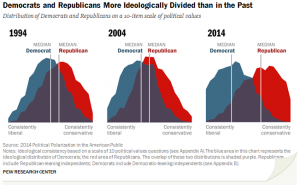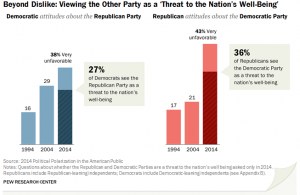The Role of Media in the Political Polarization in American Politics
Political Polarization can be defined as the process by which political parties have become more internally consistent in ideology and more ideologically distant from one another. In other words, the Republican Party has become more conservative and the Democratic Party has become more liberal. As can be seen by the graphic below, democrats and republicans are more ideologically divided than they have been in the past.
One of the biggest reasons for this is thanks to the sources where people get their news and information relating to politics from, which causes people to develop different opinions and have different attitudes that ultimately combine to shape people’s political ideologies and beliefs. When it comes to political news, it is as if liberals and conservatives are from different planets altogether. There is barely any overlap in the sources they turn to and trust. In fact, as far as discussing politics with friends is concerned, be it online or someplace physical, liberals and conservatives are more likely than others to interact with like minded individuals, which can be a problem since they get so used to having others agreeing with them that as soon as they come across a conflicting opinion, they see it as a threat.
The problem is that members of Congress consume political news and information through the same sources mentioned above and hence are bound to have the different opinions as well. However, that means coming to an agreement on important issues that are discussed in Congress is a difficult process since members differ on views but are not willing to compromise on their positions, usually because they are trying to do what their constituents want. When they are presented with opinions and views that do not align with their own, at times, they draw the conclusion that the person and/or party with said opinion is a threat to the country’s well being. The only solution that they see is implementing their own policies since they believe that the other party’s policies are extremely misguided, which means that an impasse is reached since neither side wants to give in to the other party’s ideas. This ultimately means that as a whole, Congress becomes ineffective, inefficient, and indecisive by having many bills and policies in the pipeline but failing to pass them due to a lack of agreement among members. For example, here is a list of just a few issues that the new Congress faced in January of 2015, many of which were deferred from the previous year.
The problem is not that different media sources give out different types of news and information pertaining to political issues. The problem is the fact that people are so content hearing what they like to hear that they do not even entertain opposing ideas, and that is exactly why people tend to get their news and information from largely a single source. People are being bombarded with news they like to hear and are missing out on a wholesome experience, wherein they would be able to hear and understand both sides of the issue rather than simply arguments supporting their beliefs. Since media plays a critical role in the political socialization of people, it has the power to affect the way people think, and currently, people are not thinking as much as they are being pleased. People should instead try and seek out as many different types of news they can from various sources, in order to challenge their opinions and beliefs, while keeping abreast of the goings-on in the American democracy.
Sources –
https://www.rollcall.com/news/politics/10-issues-congress-faces-january
http://www.journalism.org/2014/10/21/political-polarization-media-habits/
http://www.people-press.org/2014/06/12/political-polarization-in-the-american-public/
https://www.vox.com/policy-and-politics/2017/10/27/16553698/pew-political-typology-polarization


